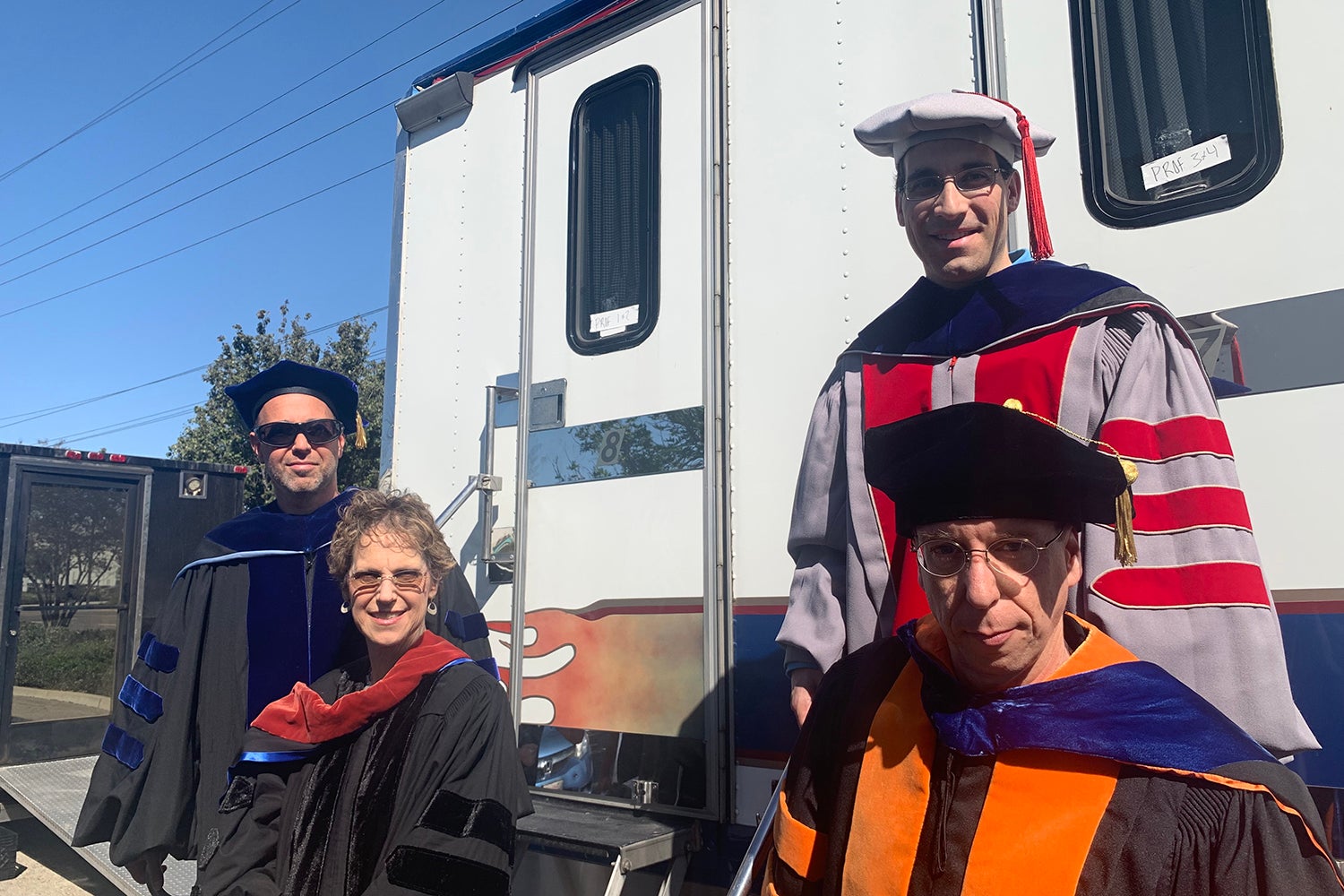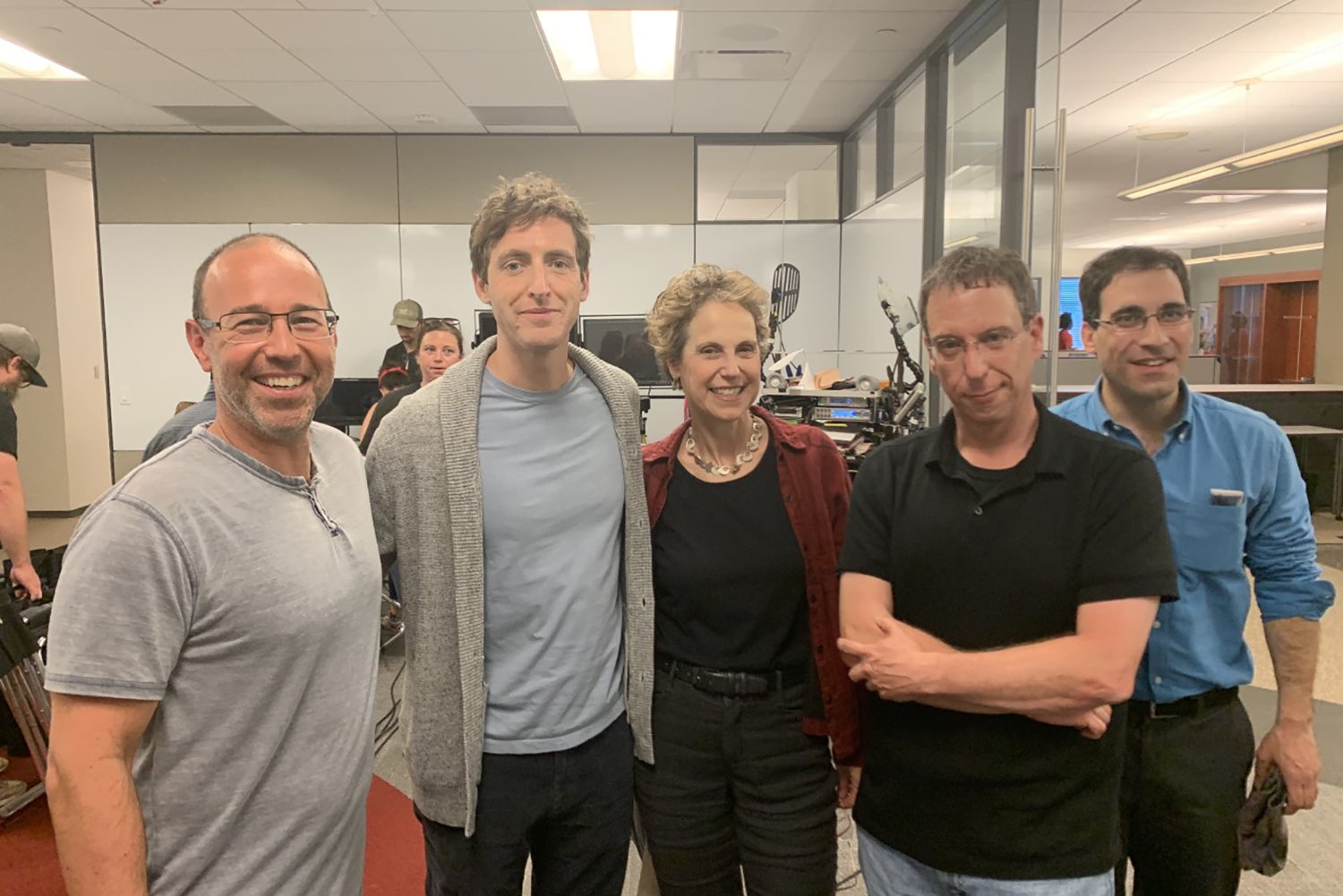Q&A with Stanford faculty on Silicon Valley
Four Stanford faculty members discuss their involvement with the HBO show Silicon Valley, which included cameos on the final episode.
If you watched the series finale of HBO’s Silicon Valley, you may have spotted a few Stanford University faces. Four Stanford faculty members – Anat Admati, the George G.C. Parker Professor of Finance and Economics in the Graduate School of Business; Dan Boneh, the Cryptography Professor and professor of computer science and of electrical engineering; Tsachy Weissman, professor of electrical engineering; and Keith Winstein, assistant professor of computer science – all had cameos on the final episode, a nod to their contributions to the show.

Stanford faculty members outside their trailer on the set of Silicon Valley. From left: Tsachy Weissman, Anat Admati, Keith Winstein, Dan Boneh. (Image credit: Jonathan Dotan)
Their involvement with Silicon Valley started when writers for the show reached out to Weissman to pick his brain about data compression, which is the focus of the startup run by the show’s main characters.
“They thought: What’s the most geeky, esoteric thing that no one understands? And they decided compression,” joked Weissman.
In this conversation with Stanford Report, the faculty members discussed the role their research subjects played on the show and how that reflects reality.
Why did you get involved with “Silicon Valley”?
Winstein: It was fun! That was the main reason. But also, things like this TV show are a part of how our students and society get messages about what computer science and the tech industry fundamentally are, so it was interesting to have a tiny role in shaping that.
Weissman: This was a way for me to try to expose some of what we do to a wider audience. I also hoped to maybe even inspire people – other than people already interested in compression – to want to go in this area.
“I view all engagements, including with a satirical series, as a form of teaching and contribution to the public discourse.”
—Anat Admati
Admati: My involvement in the last season came from discussions and co-teaching of the course Is the Internet Broken? with Silicon Valley co-producer Jonathan Dotan after we were introduced by Tsachy Weissman – who happens to be my neighbor. In the last decade, I have become aware of the importance of engaging broadly on issues of governance and policy to ensure the market system works for society. I usually talk to columnists or reporters or may write op-eds or policy comments – but I view all engagements, including with a satirical series, as a form of teaching and contribution to the public discourse.
What was it like to be involved with the show?
Boneh: I have to say, it was a lot of fun. I was initially a little apprehensive in that a lot of the work that we do is fairly mathematical. But I was very pleasantly surprised to see that there were people on the show who had math undergraduate education. So, it was quite easy for me to talk to them.
Admati: My expertise is corporate governance and finance, but the issues of who writes and enforces the rules, and how to get institutions in the private sector and in government to serve our needs as a society, arise everywhere, including the tech sector. Seeing how these serious issues can be brought out in a show like Silicon Valley was interesting and refreshing, though I only saw the impact with the final product.
Compression and cryptography played big roles in the show but are unfamiliar topics to many people. Why should the average person care about them?
Weissman: Compression is not just some geeky thing that people in tech want to do. It’s actually something very important for our planet. At the very core, it’s about using fewer resources for storing, representing and communicating our data. As a civilization, almost everything we care about – our videos and pictures, our books, our money – is just bits sitting in a ginormous farm of servers somewhere.
“This was a way for me to try to expose some of what we do to a wider audience. I also hoped to maybe even inspire people.”
—Tsachy Weissman
Today, these server farms are becoming a very large fraction of our global footprint. So, in a very concrete way, if you’re doing compression, you are contributing to ensuring a better future for our planet and the next generations.
Boneh: Cryptography protects very critical personal and private business data. Obviously, governments rely on cryptography heavily too. The way it works is through protocols built on hard problems – like trying to factor a thousand-digit number. So, if you’re problem isn’t hard, your data isn’t secure. This is why the world cares about cryptography and the hard problems that underlie cryptography.
Winstein: Almost everyone depends on these every day – even if they don’t know about it. I think that’s sort of core to what our students are learning about what it means to be an engineer: a responsibility for something that maybe not many people are necessarily even aware of, but they’ll definitely learn about if it goes awry. People don’t have to care about avionics software, but if you fly in a plane and the software misbehaves, you’re going to care. Likewise, if our credit records or the electricity grid are compromised, we’re all going to care about how information is stored and secured.
How realistic are the scenarios in the show?
Weissman: Something that unfolds in this last season has to do with the tension between compression and encryption – encryption tries to make data look random but then you can’t compress it. Both on a technical and a moral level, they deal with collecting and exploiting data, and violating user privacy, in part because of this tension. That triggers many of the conundrums and conflicts and some of the cataclysmic events that unfold in the end. It’s kind of out there but also thought-provoking – and not completely out of the realm of what might be unfolding in real life.
“One message we try to teach is that the choices that engineers make matter. … For all our sake, you’ve got to make those choices in a prudent and wise and ethical way.”
—Keith Winstein
Admati: The show paralleled governance and ethical issues happening the real world, but of course it exaggerates them.
For example, there was an episode titled “Tethics” that mocked mission statements, companies declaring they want to make all of us happy. Although these are often “cheap talk” statements and can cover up harmful actions, they remain popular.
It also reflected my current interest in how the justice system works in the corporate context. When corporations cause harm or break the laws, higher-ups who could have prevented the problems are often not held accountable.
Winstein: I help teach our department’s ethics class, CS 181: Computers, Ethics and Public Policy. Many students over the last 30-plus years have gone on to create infrastructure that shapes what the world now looks like, for better or for worse. That’s what engineering is. One message we try to teach is that the choices that engineers make matter, even if people don’t know. For all our sake, you’ve got to make those choices in a prudent and wise and ethical way. You see some of this thinking throughout the season.
Boneh: You can map a lot of what they discuss in the show to real life in a startup. Every startup faces one or two of the problems covered in the show, but everything happens to this one. It’s kind of the conglomeration of everything that’s going on in Silicon Valley, which is very funny.
“They asked me to invent something new that seemed real. … Some who see it would be amazed at this level of detail on TV and, honestly, it could lead to a new area of research.”
—Dan Boneh
Has the show taught you anything in return?
Admati: In teaching the course with Jonathan, I met a number of new people in this space and got to engage more with colleagues from engineering. This cross-disciplinary engagement is important because when we break academic silos we enrich both our research and our teaching at Stanford rather than stay in our narrow fields. Breaking silos enables us to understand the world better and improve our contributions.
Weissman: The process helped crystallize my thinking about the nature of and reasons for the gaps between information theory and practical data compression, and has whet my appetite to become more proactive about bridging them.
Any special details you advised on that we can watch for?
Weissman: For the first season finale, my former graduate student Vinith Misra came up with a mathematical formula that incorporates both how well you compress and the speed of the compression. He called it the Weissman Score. Now, it’s even been referenced in some papers.

Thomas Middleditch, star of Silicon Valley who played the role of startup founder and CEO Richard Hendricks, with Stanford faculty members who had cameos on the last episode of the series (from left: Tsachy Weissman, Thomas Middleditch, Anat Admati, Dan Boneh, Keith Winstein). (Image credit: Courtesy of Tsachy Weissman)
There is also a rather infamous scene in that season where the startup comes up with something called middle-out compression. Vinith and the writers came up with middle-out compression because the show wanted an idea for something very innovative that the company could do.
Other contributions are subtler. There’s a reference to genomic data compression in the finale that reflects the influence of my former graduate student Idoia Ochoa, who advised on previous seasons. Dmitri Pavlichin, my former postdoc, wrote much of the technical stuff you see on whiteboards. In the final episode you’ll also find a mention of the Stanford Compression Forum’s STEM to SHTEM high school internship program on Richard’s whiteboard. We were thrilled to include him as a fictional mentor to the program!
Winstein: Look in the lower-left of the whiteboard in the very final scene – he’s teaching my class CS181!
Boneh: They asked me to invent something new that seemed real. It’s in the final episode but I don’t think it’s legible. I don’t know how many people in the audience would follow it to the deepest level, but some who see it would be amazed at this level of detail on TV and, honestly, it could lead to a new area of research.
There is a reference to some work in the Center for Blockchain Research, which I co-direct, on the whiteboard in one of scenes. A lot of academic research never leaves the paper, but in the area of blockchains a lot of academic research immediately gets implemented and deployed in the real world. This is very rare and that makes it super, super exciting.
Admati is also a senior fellow at the Stanford Institute for Economic Policy Research and director of the Corporations and Society Initiative at Stanford Graduate School of Business. Boneh is also a senior fellow at the Freeman Spogli Institute for International Studies. Weissman is also a member of Stanford Bio-X and the Wu Tsai Neurosciences Institute, and director of the Stanford Compression Forum.
To read all stories about Stanford science, subscribe to the biweekly Stanford Science Digest.
